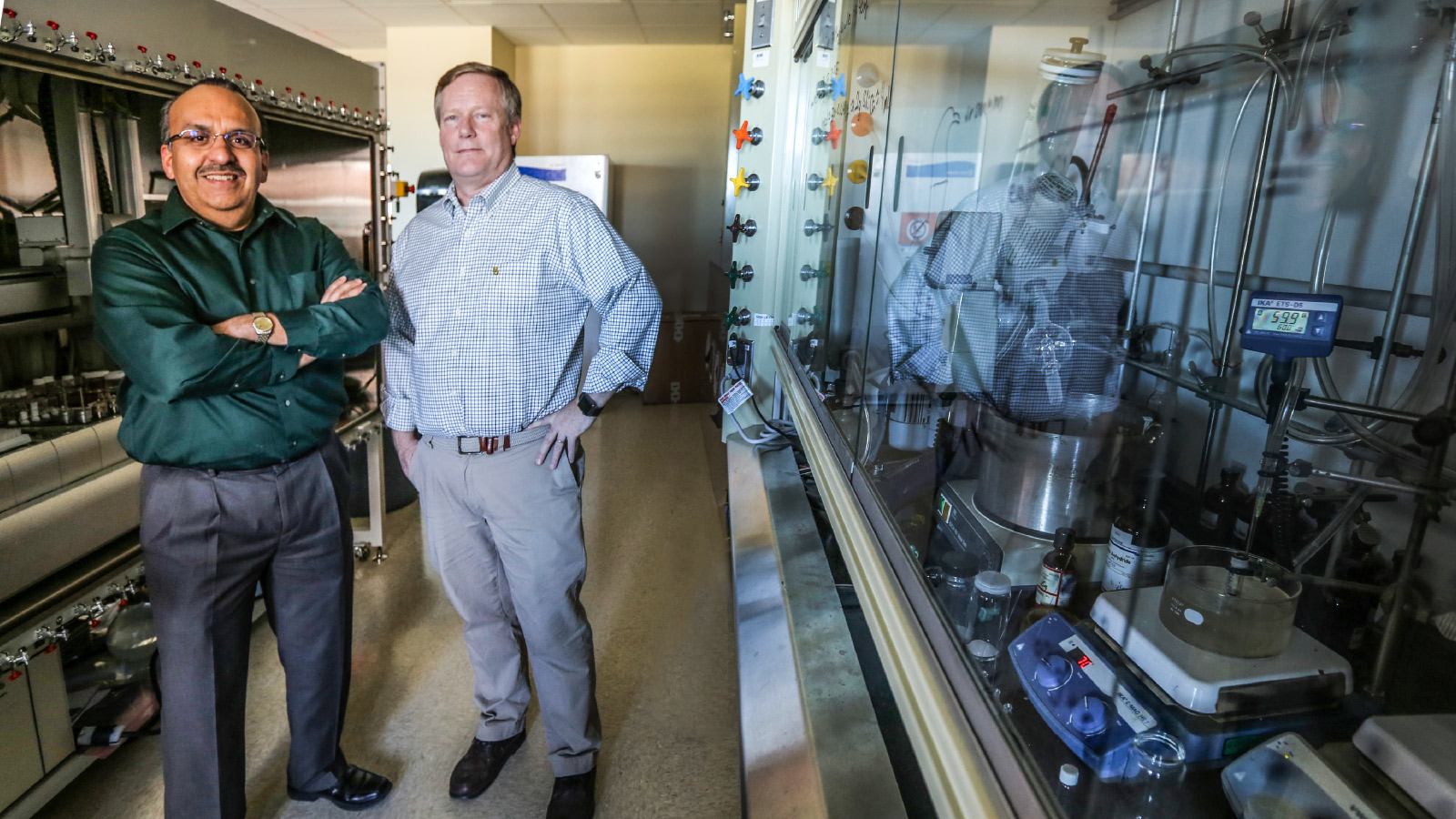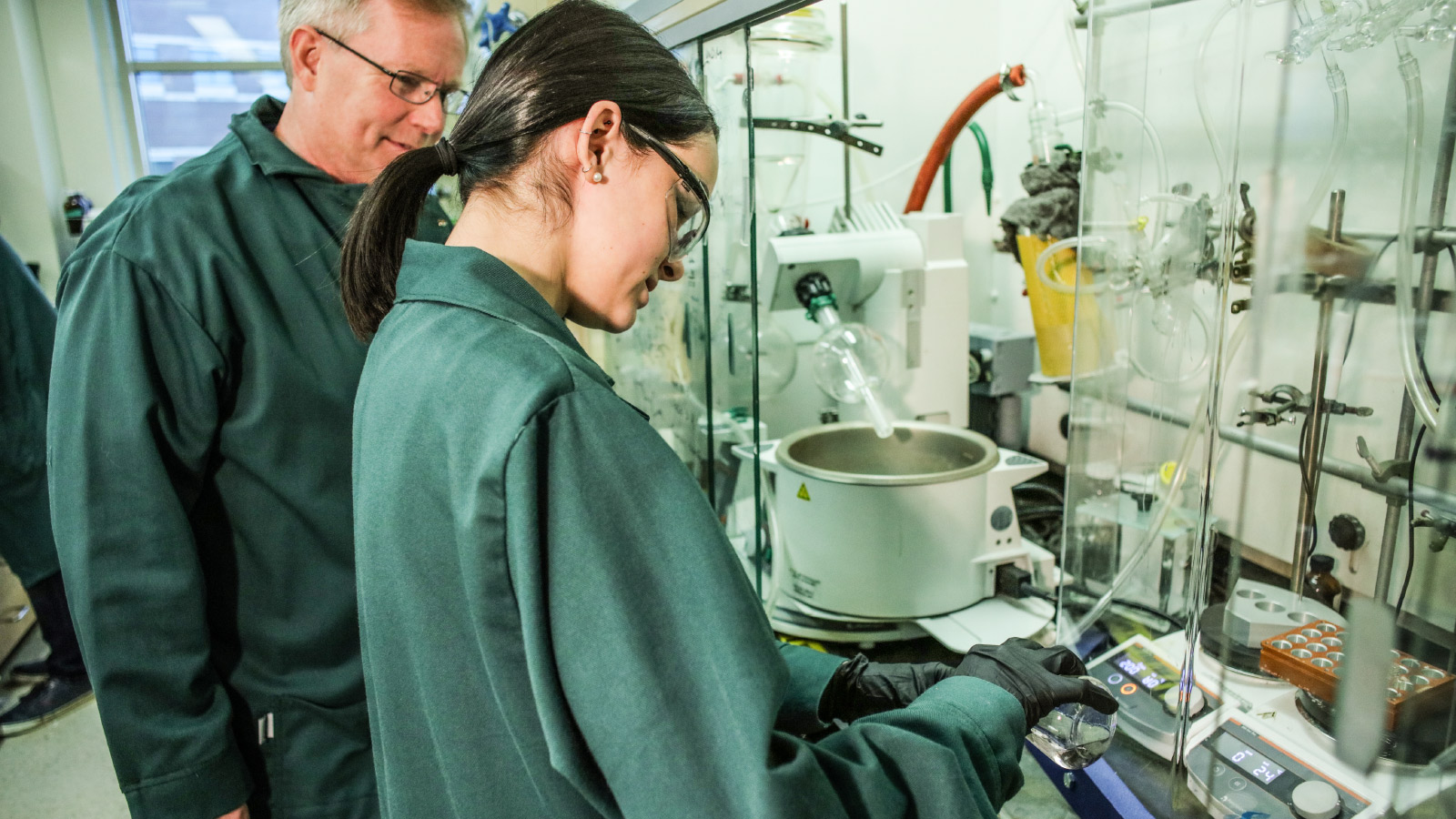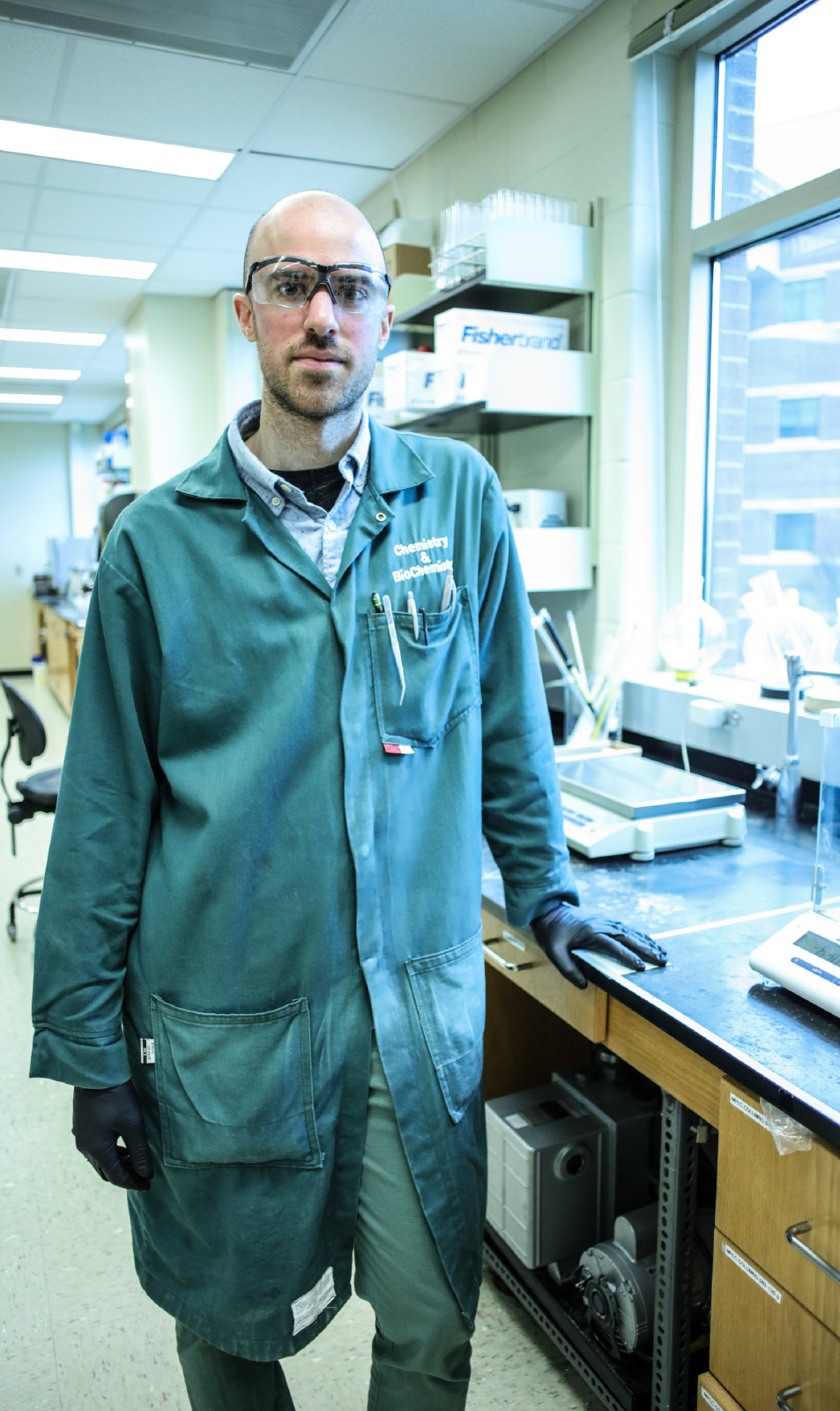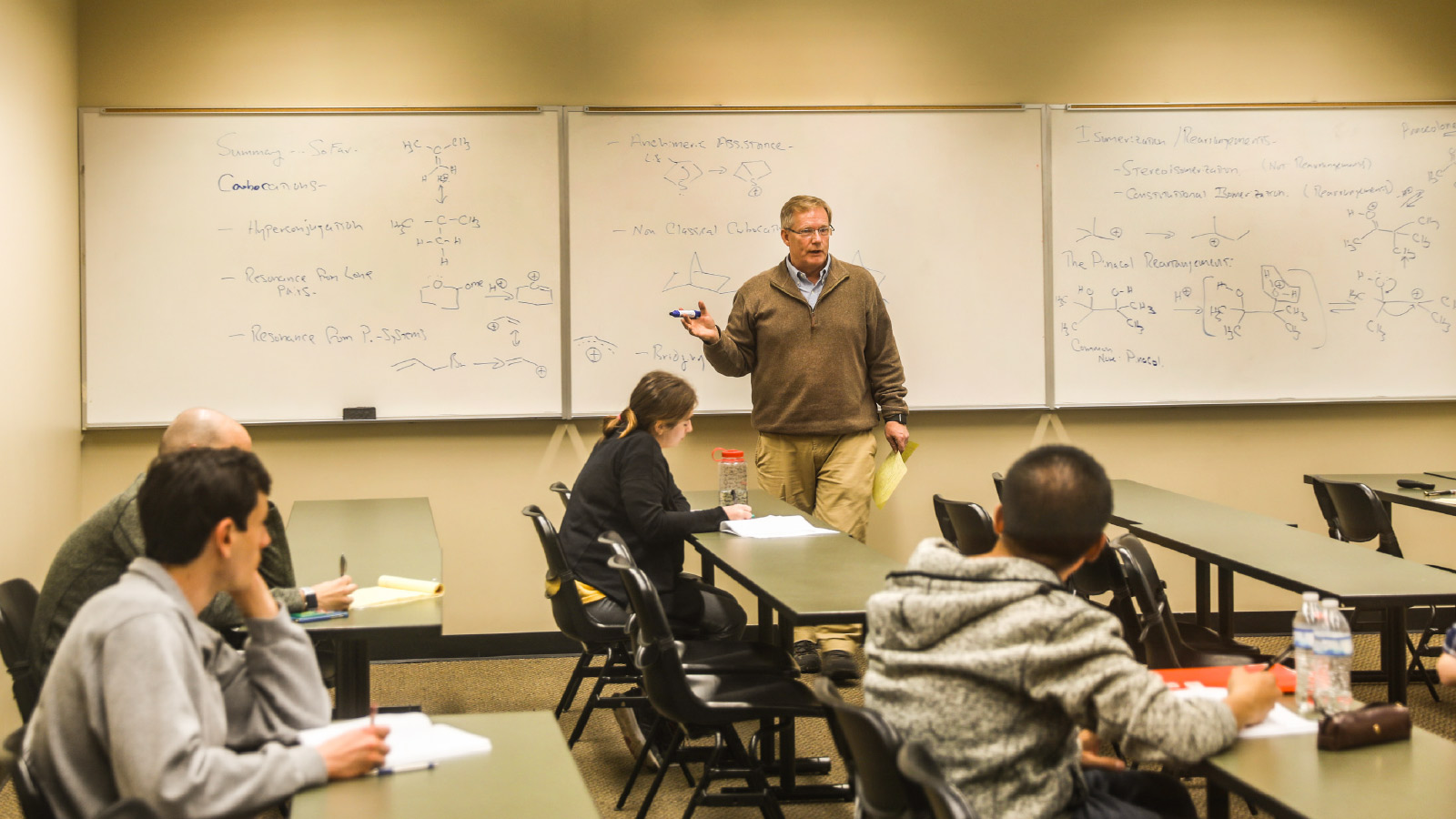Good Chemistry
Where mentoring relationships exist, breakthrough research follows.
Dr. John L. Wood, the University’s Robert A. Welch Distinguished Professor of Chemistry, averages 60 to 70 hours a week in the east wing of the Baylor Sciences Building (BSB), arriving to his office before the sun rises Monday through Saturday. A world-renowned chemist and cancer researcher, Wood is recognized for his impactful work in an area of chemistry called natural products synthesis or total synthesis, which involves re-creating complex, naturally occurring molecules in a lab setting. These molecules—derived from soil samples, plants or fungi—demonstrate biological activity that could be useful to pharmaceutical companies developing new drug therapies that target cancer.
Wood, who spent 13 years on faculty at Yale University, and six at Colorado State University before coming to Baylor in 2013, readily concedes that he doesn’t necessarily measure success in his lab in strictly chemical outcomes.
“That’s not what I’m here for,” Wood says. “In my lab, every student and post-doctoral researcher is working on synthesizing a different molecule. My job is to engage my students as a consultant, to field questions, but never to tell them what to do or what to research. I’m here to produce people who can do that creative and critical thinking for themselves.”
And produce he does. The John Wood Group has sent researchers from Baylor to such academic institutions as Massachusetts Institute of Technology (MIT) and Harvard University, as well as industry giants AbbVie and Genentech. Wood says such success goes a long way in recruiting top-flight students and faculty to Baylor, and, in turn, allows the University to compete in every way with the nation’s highest-ranked research universities.
Mina Nakhla, PhD ’18, begins a post-doctoral appointment at Harvard this spring, following the footsteps of fellow John Wood Group alumna Monica McCallum, PhD ’16. Nakhla says having Wood’s name on his curriculum vitae (CV) is invaluable.
Recruiting renowned faculty like Dr. Daniel Romo (left) and Dr. John Wood (right), and building and equipping labs where faculty, graduate and undergraduate students explore, discover and collaborate together are priority initiatives of Give Light: The Campaign for Baylor. For information about supporting faculty research at Baylor through a philanthropic gift, email GiveLight@baylor.edu.
“His name carries an enormous amount of weight, and he has produced some famous chemists,” Nakhla says.
Two such chemists for whom Wood served as doctoral advisor while at Yale are currently at the California Institute of Technology (Caltech)—Dr. Sarah E. Reisman and Dr. Brian M. Stoltz.
The CPRIT Effect
Convincing Wood to leave his home state of Colorado for Waco took every bit of two years. Dr. Patrick Farmer, chair of the Baylor Department of Chemistry and Biochemistry, says the original offer included the University’s Welch professorship, endowed by The Welch Foundation of Houston and most recently held by the late Dr. F. Gordon A. Stone. Ultimately, Wood’s commitment was sealed when Baylor was awarded a five-year, $4.2 million grant by the Cancer Prevention and Research Institute of Texas (CPRIT) in late 2012.
“I worked on writing the CPRIT grant for eight to twelve months,” Farmer says. “This type of CPRIT grant—the Recruitment of Established Investigators Award—is designated specifically for recruiting ‘big fish’ to the State of Texas, and these funds are typically awarded to medical schools and research hospitals.”
In 2011, the same type of CPRIT award helped The University of Texas MD Anderson Cancer Center recruit Dr. James Allison from New York’s Weill Cornell Graduate School of Medical Sciences. Today, Allison shares the 2018 Nobel Prize in medicine for his breakthrough research in immunotherapy.
The award that brought Wood to Baylor has allowed for the assembly of what is easily a dream lab. Inside the Baylor CPRIT Synthesis and Drug-Lead Discovery Laboratory (CPRIT Lab), long rows of counter-height work tables are crowded with instruments, a scatter of flasks and half-full test tubes. Interminable formulas are scrawled in marker on every wipeable surface. Near one active work station, a dune of unidentified powder awaits its intended purpose, along with fluids of varying tint and opacity in vials. There is, of course, the quintessential glovebox—its dark, rubber gloves hang limp and ready for use, inert as the air encased inside. Acetone, or some other solvent, perfumes the lab, but Wood says he doesn’t smell anything unusual.
“My job is to engage my students as a consultant, to field questions, but never to tell them what to do or what to research. I’m here to produce people who can do that creative and critical thinking for themselves.”
To the casual visitor, the CPRIT Lab looks much like the curated set of a big-budget sci-fi flick. To someone like Dr. Jacob Timmerman, the lab looks like a jackpot.
Timmerman, a post-doctoral researcher with the John Wood Group, began working in labs as a freshman at the University of North Carolina at Chapel Hill. He recently accepted a full-time position at San Francisco biotech corporation Genentech.
“I’ve been doing this a long time, and the lab here that [Wood] has put together is second to none,” Timmerman says. “It allows us to be incredibly efficient. We have instant access to instrumentation that, at another school, might be shared among a number of departments or research groups.”
It is rare, for instance, for a chemistry department to have access to five nuclear magnetic resonance (NMR) instruments ranging in strength from 300 to 600 megahertz (MHz). These instruments are able to provide details of the structure of a molecule and its individual atoms—something approaching an “image”—and are among the most definitive methods in identifying organic compounds, proteins and other complex molecules. With a portion of the CPRIT funding (roughly $1.5 million), two aging NMRs were replaced in 2013 with three new, more powerful ones.
“The lab facilities at Yale were not as good as those at Colorado State, which were not as good as what we have here at Baylor,” Wood says. “The CPRIT grant was not only key in recruiting me here, it is the key to what I believe will be a lasting impact. Those funds have directly benefitted our cancer research, but there are also tangential benefits as we continue to establish Baylor as a top research university. It’s important that our instrumentation is able to attract graduate students and post-doctoral researchers, and other faculty members—junior faculty as well as established investigators looking at moving their research operation to Baylor.”
One such established investigator is Dr. Daniel Romo, The Schotts Professor of Chemistry and co-director of the CPRIT lab. Recruited in 2015 from Texas A&M University, Romo says the chances of his move to Baylor would have been nil if the state-of-the-art NMR instruments weren’t in place. Like Wood’s research group, the Romo Group focuses on synthesizing compounds derived from nature and understanding their biological effects in cells at the molecular level.
Aside from the instrumentation available, applicants to the graduate program also care about the facilities in terms of the building’s appearance and the work environment, Wood says. And the CPRIT lab is no subterranean bunker. Large, picture windows line the north wall, drenching everything in natural light. The view from the second floor of the BSB allows strained, goggle-protected eyes to rest on some point in the distance or take in a Quidditch match on the playing fields below.
“Baylor does a wonderful job of taking care of this facility,” Wood said. “The maintenance team is regularly shampooing the carpets, waxing the floors, washing the outside of the buildings. These touches make a huge difference. There is someone who goes around and takes care of the plants in the hallways—I don’t do that. Those kinds of details make this a place where people want to work.”
Additionally, the price the John Wood Group pays to run instruments like the 600-MHz NMR is negligible compared to costs elsewhere.
“The cost for researchers to live in Waco is low, of course, and you can get a lot of research done with the dollars that you spend,” Wood says. “It’s hard to raise research funds, but every dollar goes a long way here.”
Pure Science
In his group, Wood isn’t the only one logging long hours. His researchers are expected to spend a minimum of 60 hours a week in the lab, and he is very up-front about this expectation when interviewing prospects. However, Nakhla says many researchers work 80- to 90-hour weeks.
“What you have to realize is that when these students go looking for post-doctoral appointments or jobs either in academia or the private sector, they’re going to be competing with students from Harvard, MIT, Penn, Ohio State and University of Chicago,” Wood says. “Those people are working pretty hard, too. This is a special time—for graduate students in particular—to focus on this one thing and set themselves on a trajectory that will carry them through their career, through their life. Now is the time to get it done and get it done right.”
To recap, total synthesis means putting a molecule together a few atoms at a time using commercially available materials. The catch is that for most molecules, there are an infinite number of conceivable syntheses. It is no stretch to view a completed total synthesis as one might a sculpture by Rodin or Bernini.
“This type of work isn’t something I can look up in a book and then go do in the lab. That’s not how this works,” Nakhla says. “I know what’s been done before based on my studies, and often I must try to ignore all that and just find any way to construct this molecule, to connect each of its atoms in a way no one has before. I have to develop completely new chemistry.”
Often, the molecules Nakhla and others synthesize in lab are not exactly plentiful in nature.
“In some cases, hundreds of kilograms of plant matter are ground up in order to extract the compound, to produce a single sample of just a few milligrams to use in lab.” Nakhla says.
“We have instant access to instrumentation that, at another school, might be shared among a number of departments or research groups.”
The chemistry he and his fellow researchers develop and publish enables the efficient production of these molecules on an industrial scale. Getting it right can take many months, years or even decades. Nakhla’s recent synthesis of a compound called aspergilline A, which exhibited anti-cancer activity, took approximately two years to complete. Another compound known as phomoidride D required 22 years and the dogged patience of 19 John Wood Group chemists to synthesize.
“Isolated by the natural products group at Pfizer in Connecticut, phomoidride D came from a fungus that was growing on a juniper bush in Dripping Springs, Texas,” Wood says. “It was found to lower cholesterol levels and also inhibit some forms of cancer. So, conceivably, it could serve as a lead compounds whose structure a pharmaceutical company may modify as they try and develop a safer, more effective drug.”
If Wood seems uninterested in the commercial viability of his work, that’s because he is—entirely.
“I don’t believe the university’s job is to be in the drug development business,” Wood says. “Pharmaceutical companies are far better than universities at developing drugs, getting them through clinical trials and then to market.
“I’m in the business of educating students in how to look at a molecule and put it together in the lab. If there is something we can patent, we can do that; but that’s where we stop. I’m not interested in all the details that go into turning this or that lead molecule into a commercial product. I’m interested in my students, their day-to-day problems and helping them solve their research questions.”
Senior biochemistry major Alexandra Beard is one of three undergraduate students selected to work with the John Wood Group. Beard, who is currently applying to chemistry doctoral programs, says she fell in love with total synthesis during a summer 2017 internship at the University of North Texas. Currently, she is working on synthesizing a compound she found in an academic paper, even though it doesn’t necessarily exhibit the qualities that may be useful to a pharmaceutical company, she’s learned to be drawn to a challenge.
“I chose it because it’s really complex,” Beard says. “I love this work because every day we come in and get to do something that’s never been done before. That’s what’s so cool. This work is hard and everyone is putting in so many hours to solve these problems that you have to really love what you’re doing. Everyone’s here for the chemistry.”
Still, Romo notes that nearly half of all drugs on the market are derived from natural products. Looking at antibiotics and anti-cancer drug therapies alone, that figure jumps to about 70 percent.
“I love this work because every day we come in and get to do something that’s never been done before. That’s what’s so cool. This work is hard and everyone is putting in so many hours to solve these problems that you have to really love what you’re doing.”
In the hallway between Wood’s office and the CPRIT lab, large posters feature the chemical structures of hundreds of marketed drug molecules, developed and prepared by researchers at companies like Pfizer, GlaxoSmithKline or Eli Lilly. By varying a lead compound like phomoidride D over and over again, pharmaceutical companies develop the molecules that become the most frequently prescribed drugs in the world. So, the Wood and Romo groups work at the earliest stage of the odyssey known as drug discovery.
“I consider natural products a ‘playground’ provided by God for us to explore, synthesize, and harvest for potential medicines,” Romo says. “It’s fertile ground for us to identify lead molecules that may ultimately provide new medicines.
“But, neither John nor I are interested in being the person who creates a drug. What we do enables other chemists, or pharmaceutical companies, to study these compounds further. The compounds that go to Phase 1 clinical trials are not the initial lead compounds we’re synthesizing here in our labs—not even close. There could be 1,000 to 10,000 analogs [variations of the same compound] studied between the initial lead we might synthesize and the compound that makes it into Phase 1 studies.”
While the compounds being investigated and synthesized in the CPRIT lab may someday lead to a groundbreaking new drug, the greatest impact of Wood’s education-first ethos is on the lives of his students.
“We’re here a lot, and we get to know each other and John really well,” Timmerman says. “He stays involved in our lives even after we leave and move on to other schools and jobs.”
Now an MIT post-doctoral scholar, Heemal Dhanjee, PhD ’17, still speaks with Wood on a monthly basis—as often as he speaks with his mother and father, he says. The indelible personal and professional support Dhanjee received at Baylor—and continues to receive from afar—reflects a culture Wood has cultivated intentionally.
“He helped me navigate some very difficult problems—not just in chemistry, but in life as well,” Dhanjee says. “Twenty years from now, I may or may not remember the finer details of the research I undertook while under John’s tutelage. But, I will remember him coming into lab in sweatshirt and sweatpants to talk with me; I’ll remember my lab mates bringing me lunch and dinner when I was pressed for time; I’ll remember going to dinner with Jacob Timmerman and others to celebrate an award our group had won. In that time, I built a lifelong network of friends that span the globe and, much like my biological family, I feel like I can contact any one of them for just about anything.”



